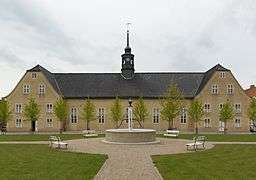Christiansfeld
| Christiansfeld | |
| Town | |
 The Moravian Church in Christiansfeld | |
| Country | Denmark |
|---|---|
| Region | Southern Denmark (Syddanmark) |
| Municipality | Kolding |
| Coordinates | DK 55°21′24″N 9°29′11″E / 55.35667°N 9.48635°ECoordinates: DK 55°21′24″N 9°29′11″E / 55.35667°N 9.48635°E |
| Population | 2,855 (2014) |
| Timezone | CET (UTC+1) |
| - summer (DST) | CEST (UTC+2) |
| Postal code | 6070 Christiansfeld |
| UNESCO World Heritage Site | |
| Name | Christiansfeld, a Moravian Church Settlement |
| Year | 2015 (#39) |
| Number | 1468 |
| Region | Europe and North America |
| Criteria | (iii)(iv) |
 Christiansfeld (left center) in Denmark
| |
| Website: www.christiansfeldcentret.dk (Danish) | |
Christiansfeld, with a population of 2,855 (1 January 2014),[1] is a town in Kolding Municipality in Southern Jutland in Region of Southern Denmark. The town was founded in 1773 by the Moravian Church and named after the Danish king Christian VII.[2] Since July 2015 it has been a UNESCO World Heritage Site.
History
Most of Christiansfeld was constructed in the years 1773-1800, following a strict city plan. To encourage construction, king Christian VII promised a ten-year tax holiday for the city and paid 10% of the construction costs of new houses. It was one of many towns in Schleswig officially designated a small market town (flække).
In 1864, Christiansfeld and the rest of Schleswig was ceded to Prussia as a result of Denmark's defeat in the Second Schleswig War. It remained a part of Germany until 1920 when, as a part of a plebiscite called for by the Treaty of Versailles, Northern Schleswig voted to rejoin Denmark. After reunification, the Moravian church lost some of the rights it had obtained as a part of the town's founding in the 18th century. For example, it no longer had the ability to choose the towns leadership, paving the way for the town's first Danish mayor who was not a member of the church in 1920.[3] The church also sold its schools at this time due to the declining membership of its congregation.
From 1970 to 2007, the town was the administrative seat of Christiansfeld Municipality, but it lost this status and was placed in the Kolding Municipality as a part of the Municipal Reform of 2007 (Kommunalreformen 2007).
Today, the city is a tourist attraction: the old city core, the Moravian Church with its light, simple and impressive hall and the special cemetery draw thousands of tourists each year. Its well preserved architecture is one of the reasons it was nominated as a tentative UNESCO World Heritage Site in 1993.[4] It was finally inscribed on the main list on 4 July 2015.[5]
The town is famed for its honey cakes. These are baked to a secret recipe from 1783. Until 2008, the cakes were baked in the original 18th-century bakery, which was then renovated because of new national sanitary standards, but still uses the original recipes.
 Christiansfeld 1780
Christiansfeld 1780 The church cemetery
The church cemetery.jpg) House in Christiansfeld
House in Christiansfeld
References
- ↑ "BEF44: Population 1st January, by urban areas" database from Statistics Denmark
- ↑ Dansk Stednavne Leksikon, JYLLAND - Sydlige del, FYN med omliggende øer, (page 30). ISBN 87-00-55221-6 (in Danish)
- ↑ A Town Walk in Christiansfeld
- ↑ UNESCO World Heritage Centre
- ↑ "Sites in Denmark, France and Turkey inscribed on UNESCO's World Heritage List". unesco.org. UNESCO. 4 July 2015. Retrieved 8 July 2015.
External links
![]() Media related to Christiansfeld at Wikimedia Commons
Media related to Christiansfeld at Wikimedia Commons
